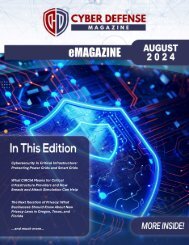Cyber Defense eMagazine June 2020 Edition
Cyber Defense eMagazine June Edition for 2020 #CDM #CYBERDEFENSEMAG @CyberDefenseMag by @Miliefsky a world-renowned cyber security expert and the Publisher of Cyber Defense Magazine as part of the Cyber Defense Media Group as well as Yan Ross, US Editor-in-Chief, Pieruligi Paganini, Co-founder & International Editor-in-Chief, Stevin Miliefsky, President and many more writers, partners and supporters who make this an awesome publication! Thank you all and to our readers! OSINT ROCKS! #CDM #CDMG #OSINT #CYBERSECURITY #INFOSEC #BEST #PRACTICES #TIPS #TECHNIQUES
Cyber Defense eMagazine June Edition for 2020 #CDM #CYBERDEFENSEMAG @CyberDefenseMag by @Miliefsky a world-renowned cyber security expert and the Publisher of Cyber Defense Magazine as part of the Cyber Defense Media Group as well as Yan Ross, US Editor-in-Chief, Pieruligi Paganini, Co-founder & International Editor-in-Chief, Stevin Miliefsky, President and many more writers, partners and supporters who make this an awesome publication! Thank you all and to our readers! OSINT ROCKS! #CDM #CDMG #OSINT #CYBERSECURITY #INFOSEC #BEST #PRACTICES #TIPS #TECHNIQUES
Create successful ePaper yourself
Turn your PDF publications into a flip-book with our unique Google optimized e-Paper software.
The threat landscape is evolving<br />
There is a growing amount of fragmentation in the types of ransomware attacks in play today. Chief<br />
Security Officers (CSOs) mainly associate ransomware with data encryption. This involves malicious<br />
agents gaining access to sensitive or mission-critical data and encrypting it. The ‘deal’ in this scenario is<br />
the business pays a ransom in exchange for files to be decrypted and returned to their original, usable<br />
form. This is by no means the only threat for CSOs to consider. In other cases, cyber-attackers will upload<br />
data instead of encrypting it. This means the ransom is to prevent a public leak of potentially sensitive<br />
data.<br />
These disguises and behaviours make it very difficult to consistently defend against the widening<br />
landscape of threats. The golden rule for organizations to follow is to maintain a clear view of what is<br />
normal behaviour within their own IT infrastructure. This can be achieved through continuously monitoring<br />
data and cloud storage, as well as leverage analytics on networks, operating systems and applications.<br />
This increased awareness of what a secure state of play looks like can make suspicious and malicious<br />
activity easier to spot, crucially accelerating time to response.<br />
Making good use of encryption is also key for organizations. If malicious threats cannot ‘see’ your data,<br />
it’s more difficult for them to use it against you. According to Duo’s Privacy in the Internet Trends report,<br />
87% of web traffic is encrypted – a number that is rising all the time. However, it is less clear what<br />
percentage of enterprises’ data is encrypted. Zscaler’s IoT in the Enterprise found that 91.5% of traffic<br />
on enterprise IoT networks is non-SSL encrypted. These contrasting figures suggest there is a sizable<br />
gap between how enterprises generally are leveraging encryption versus major web platforms and<br />
service providers.<br />
Are backups cyber-crime’s high-value target?<br />
One area where encryption is vital to bolster organizations’ defences against ransomware and insider<br />
threats is implementing ‘nearline’ encryption on data backups. The Veeam 2019 Cloud Data Management<br />
report found that over two thirds of organizations are producing backups of their data. While this is, of<br />
course, a good thing, imagine the blackmail potential for a cyber-attacker of gaining access to a backup<br />
of an organization’s entire digital infrastructure?<br />
Given that cyber-criminals using ransomware to blackmail businesses are looking for data, in theory they<br />
can find whatever they need in an organization’s backed up files. These could be in all manner of forms:<br />
from system disks and removable hard drives, to offline tape devices and cloud backups. Whichever<br />
option a business chooses, the backup repository itself must be protected against attack with an ultraresilient<br />
media type. Otherwise, there’s a chance that in attempting to protect business continuity,<br />
businesses may be creating a trove of poorly protected data that could be used against them.<br />
For some threat behaviours, this can be mitigated by encrypting backups every step of the way – from<br />
the first disk resource on-premises. Encrypting backups historically is a great idea when tapes leave the<br />
IT facility or if data is transmitted over the Internet. Given the prevalence of modern cyber-threats,<br />
encryption must take place nearer to the backing up process. The most effective technique however is<br />
resiliency in the backup data.<br />
<strong>Cyber</strong> <strong>Defense</strong> <strong>eMagazine</strong> –<strong>June</strong> <strong>2020</strong> <strong>Edition</strong> 120<br />
Copyright © <strong>2020</strong>, <strong>Cyber</strong> <strong>Defense</strong> Magazine. All rights reserved worldwide.


















